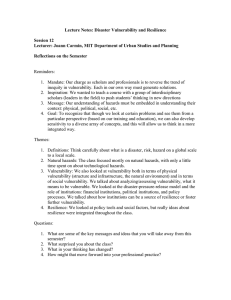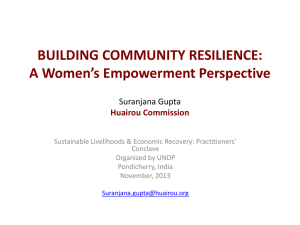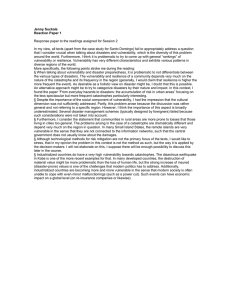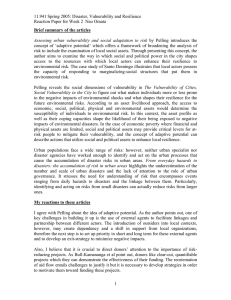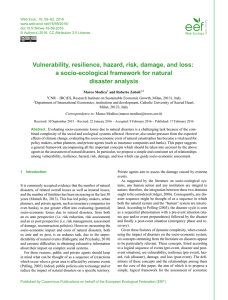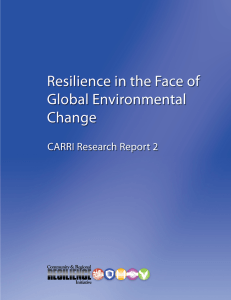Well-being of Adolescents in Military Families: Examining the Intersections of Resilience and Vulnerability
advertisement
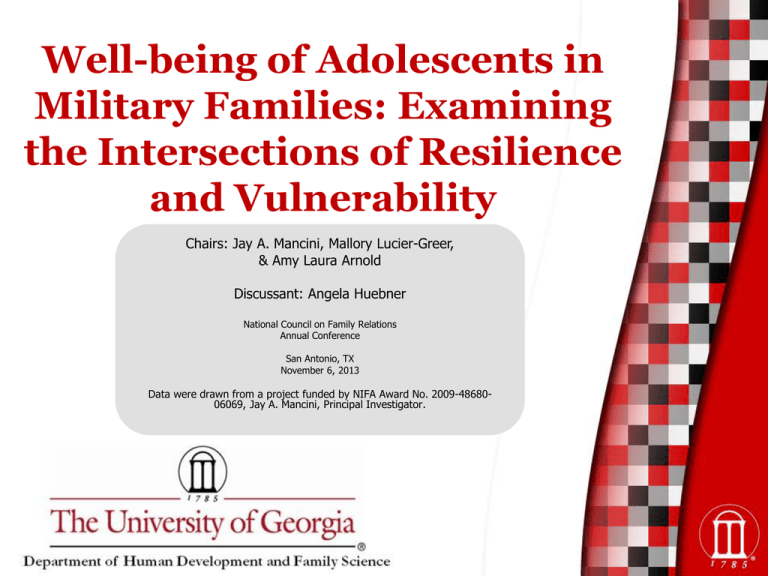
Well-being of Adolescents in Military Families: Examining the Intersections of Resilience and Vulnerability Chairs: Jay A. Mancini, Mallory Lucier-Greer, & Amy Laura Arnold Discussant: Angela Huebner National Council on Family Relations Annual Conference San Antonio, TX November 6, 2013 Data were drawn from a project funded by NIFA Award No. 2009-4868006069, Jay A. Mancini, Principal Investigator. Resilience and Vulnerability Among Adolescents in Military Families: Theoretical and Research Perspectives Jay A. Mancini, The University of Georgia Catherine Walker O’Neal, The University of Georgia The Complexity of Intersections Layers and Levels of Human Development and Contexts (Lerner) Resilience and Vulnerability • Resilience – Process of successfully overcoming adversity – Capacity to adapt – Return to baseline + thriving • Vulnerability – Experiences, situations, or characteristics that expose a person to additional negative experiences and results – Risk – Increase odds of poor results – Internal and external elements – Chronic and acute Core Questions • What should we know about vulnerability and resilience? • How are outcomes affected by them? Survey • • • • Personal and family demographics Military characteristics (e.g., parental rank) Program Involvement Social Networks – Social provisions – Relationship quality: peers, family, and community • Adolescent Well-being – – – – Academic functioning and school enjoyment Emotional well-being Problem-solving and coping strategies Personal efficacy Survey Screenshot: Child Anxiety Survey Screenshot: Child Self-Efficacy Demographics (N = 1,036) • 50.3% female participants • Racially diverse sample European American (38.7%) 9.80% 15.50% 5.50% 11.70% 38.70% 18.80% African American (18.8%) Hispanic/Latino (11.7%) Indian/AK or HI Native (5.5%) Multiracial (15.5%) Other (9.8%) Age • Mean age: 13.39 years – 72.4% were 11 to 14 years old – 27.6% were 15 to 18 years old • Grade 5th (10.7%) 5.4% 5.9% 10.7% 7th (20.3%) 8.7% 22.0% 12.2% 14.7% 6th (22.0%) 20.3% 8th (14.7%) 9th (12.2%) 10th (8.7%) 11th (5.4%) 12th (5.9%) School Background • School Type – – – – – Public school off post (62.5%) Public school on post (16.9%) Department of Defense school (11.6%) Home school (5.9%) Private school off post (3.1%) • School Transitions in Past 5 years – 64.3% changed schools 2+ times – Average of 2.4 transitions in the past 5 years Family Environment • Family Structure (who they live with) – Both their mother & father (67.3%) – Single parent (10.9%) – Stepfamily (17.3% ) – Another relative (1.1%) – Other type of family structure (3.4%) • 95.7% had a sibling Military Context • Parental Rank – 72.4% Enlisted – 27.6% Officer • 8.1% - More than one parent in the military • 18% - Parent currently deployed to a combat zone
